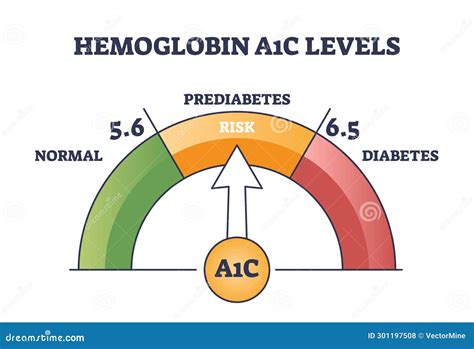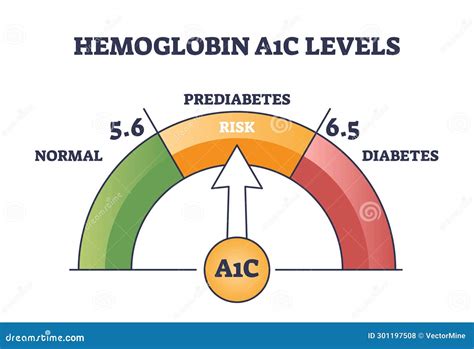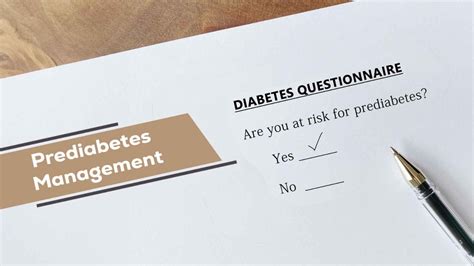Intro
Learn about prediabetes range A1c levels, borderline diabetes, and impaired glucose tolerance, understanding the signs, symptoms, and risks to take control of blood sugar management and prevent type 2 diabetes.
The prediabetes range A1c levels are a critical indicator of an individual's risk of developing type 2 diabetes. Prediabetes is a condition where blood sugar levels are higher than normal, but not high enough to be classified as diabetes. The American Diabetes Association (ADA) recommends using the hemoglobin A1c (HbA1c) test to diagnose and monitor prediabetes. In this article, we will delve into the world of prediabetes, exploring the importance of A1c levels, the benefits of early detection, and the steps individuals can take to prevent the onset of type 2 diabetes.
Prediabetes is a silent killer, often going undiagnosed until it's too late. According to the Centers for Disease Control and Prevention (CDC), over 88 million adults in the United States have prediabetes, and 90% of them are unaware of their condition. The good news is that prediabetes can be reversed with lifestyle changes and early intervention. By understanding the prediabetes range A1c levels, individuals can take control of their health and prevent the devastating consequences of type 2 diabetes.
The HbA1c test measures the average blood glucose levels over the past 2-3 months. It's a simple blood test that provides a snapshot of an individual's glucose control. The ADA recommends the following HbA1c ranges for diagnosing and monitoring prediabetes:

Prediabetes Range A1c Levels Explained
The prediabetes range A1c levels are between 5.7% and 6.4%. This range indicates that an individual's blood sugar levels are higher than normal, but not high enough to be classified as diabetes. The HbA1c test is a critical tool for diagnosing and monitoring prediabetes, as it provides a clear indication of an individual's risk of developing type 2 diabetes.Individuals with an HbA1c level between 5.7% and 6.4% are at a higher risk of developing type 2 diabetes and cardiovascular disease. However, with early intervention and lifestyle changes, it's possible to reverse prediabetes and prevent the onset of type 2 diabetes. The benefits of early detection and intervention include:
- Reduced risk of developing type 2 diabetes
- Improved blood sugar control
- Reduced risk of cardiovascular disease
- Improved overall health and well-being

Benefits of Early Detection
Early detection of prediabetes is critical for preventing the onset of type 2 diabetes. By identifying individuals with prediabetes, healthcare providers can recommend lifestyle changes and interventions to reverse the condition. The benefits of early detection include: * Improved blood sugar control * Reduced risk of cardiovascular disease * Improved overall health and well-being * Reduced risk of developing type 2 diabetesEarly detection also allows individuals to make informed decisions about their health. By understanding their risk of developing type 2 diabetes, individuals can take control of their health and make lifestyle changes to prevent the onset of the disease.

Steps to Prevent Type 2 Diabetes
Preventing type 2 diabetes requires a combination of lifestyle changes and early intervention. The following steps can help individuals prevent the onset of type 2 diabetes: * Lose weight: If you're overweight or obese, losing weight can help improve blood sugar control and reduce the risk of developing type 2 diabetes. * Exercise regularly: Regular physical activity can help improve blood sugar control and reduce the risk of developing type 2 diabetes. * Eat a healthy diet: Eating a healthy, balanced diet that's low in sugar and saturated fats can help improve blood sugar control and reduce the risk of developing type 2 diabetes. * Get enough sleep: Getting enough sleep is critical for overall health and well-being. Aim for 7-8 hours of sleep per night. * Manage stress: Chronic stress can increase the risk of developing type 2 diabetes. Engage in stress-reducing activities like yoga or meditation to help manage stress.
Lifestyle Changes for Prediabetes
Lifestyle changes are critical for managing prediabetes and preventing the onset of type 2 diabetes. The following lifestyle changes can help individuals with prediabetes improve blood sugar control and reduce the risk of developing type 2 diabetes: * Eat a healthy, balanced diet that's low in sugar and saturated fats * Exercise regularly, aiming for at least 150 minutes of moderate-intensity physical activity per week * Lose weight, if you're overweight or obese * Get enough sleep, aiming for 7-8 hours per night * Manage stress, engaging in stress-reducing activities like yoga or meditationBy making these lifestyle changes, individuals with prediabetes can improve blood sugar control, reduce the risk of developing type 2 diabetes, and improve overall health and well-being.

Monitoring and Managing Prediabetes
Monitoring and managing prediabetes requires regular check-ups with a healthcare provider and lifestyle changes. The following steps can help individuals monitor and manage prediabetes: * Get regular check-ups with a healthcare provider to monitor blood sugar levels and adjust treatment plans as needed * Use a blood glucose meter to monitor blood sugar levels at home * Keep a food diary to track eating habits and identify areas for improvement * Engage in regular physical activity to improve blood sugar control and reduce the risk of developing type 2 diabetes
Working with a Healthcare Provider
Working with a healthcare provider is critical for monitoring and managing prediabetes. A healthcare provider can help individuals: * Develop a personalized treatment plan to manage prediabetes * Monitor blood sugar levels and adjust treatment plans as needed * Provide education and support to help individuals make lifestyle changes and manage prediabetes * Refer individuals to specialists, such as registered dietitians or certified diabetes educators, for additional support and guidanceBy working with a healthcare provider, individuals with prediabetes can get the support and guidance they need to manage their condition and prevent the onset of type 2 diabetes.

Conclusion and Next Steps
In conclusion, prediabetes is a critical health condition that requires early detection and intervention. By understanding the prediabetes range A1c levels, individuals can take control of their health and prevent the onset of type 2 diabetes. Lifestyle changes, such as eating a healthy diet, exercising regularly, and losing weight, can help individuals with prediabetes improve blood sugar control and reduce the risk of developing type 2 diabetes.We invite you to share your thoughts and experiences with prediabetes in the comments below. If you have any questions or concerns, please don't hesitate to reach out. Together, we can work towards a healthier future and prevent the devastating consequences of type 2 diabetes.

What is the prediabetes range A1c levels?
+The prediabetes range A1c levels are between 5.7% and 6.4%.
How can I prevent type 2 diabetes if I have prediabetes?
+To prevent type 2 diabetes, individuals with prediabetes should make lifestyle changes, such as eating a healthy diet, exercising regularly, and losing weight.
What are the benefits of early detection and intervention for prediabetes?
+The benefits of early detection and intervention for prediabetes include improved blood sugar control, reduced risk of cardiovascular disease, and improved overall health and well-being.
